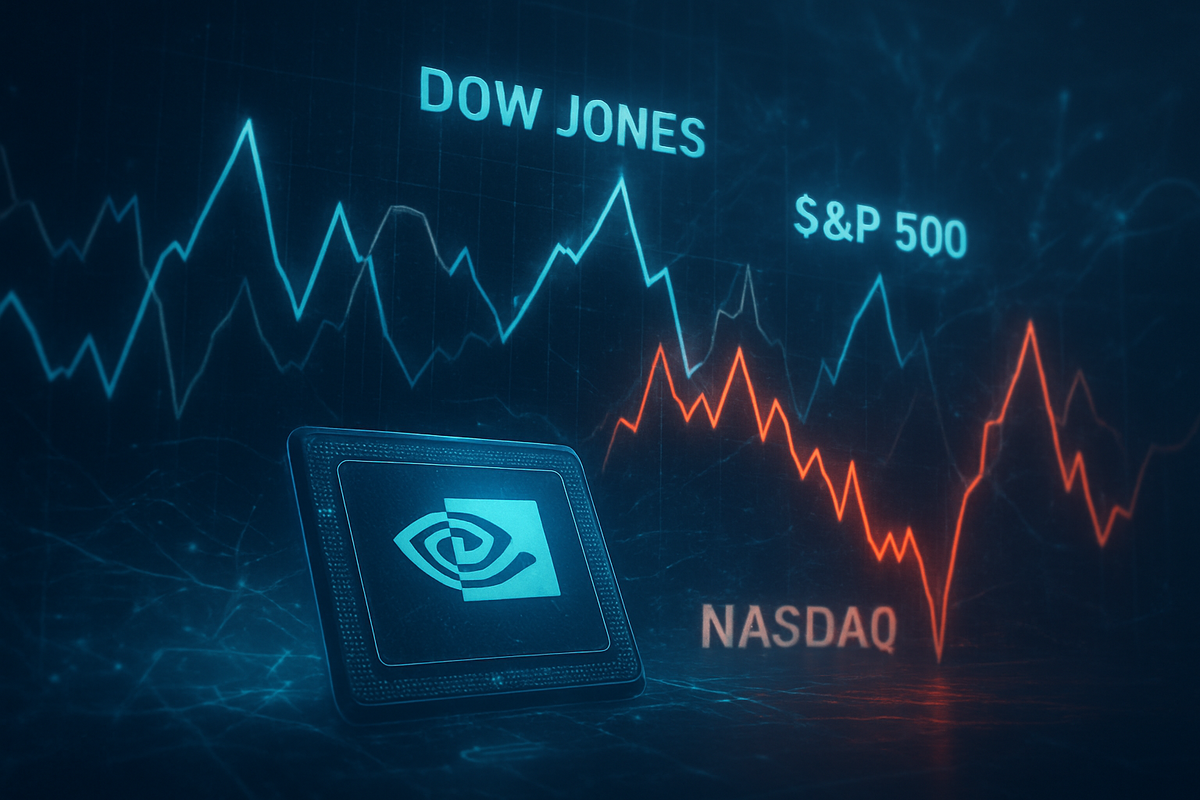
The financial markets have been a tempestuous sea in the days leading up to Nvidia's (NASDAQ: NVDA) highly anticipated third-quarter 2025 earnings report, released after market close on Wednesday, November 19, 2025. A pervasive sense of caution, bordering on skepticism, has gripped investors, manifesting in a broad selloff across the Dow Jones Industrial Average (Dow), S&P 500, and particularly the tech-heavy Nasdaq Composite. As the bell tolled for Nvidia's disclosure, the market found itself at a critical juncture, with the report poised to either reaffirm the vigor of the artificial intelligence (AI) boom or signal a significant recalibration of investor expectations.
The week preceding the earnings call was characterized by heightened volatility and a distinct de-risking trend, as market participants wrestled with concerns over potentially overstretched valuations in the AI sector. Nvidia's performance, often seen as a bellwether for the entire AI industry, was thus under intense scrutiny, with its results expected to dictate the immediate trajectory for technology stocks and potentially the broader market.
Pre-Earnings Jitters Send Waves Through Major Indices
The trading week leading up to Nvidia's (NASDAQ: NVDA) Q3 2025 earnings report was marked by a palpable sense of apprehension, translating into a significant downturn across major U.S. stock indices. From Monday, November 17, to Tuesday, November 18, 2025, the Dow, S&P 500, and Nasdaq Composite each recorded consecutive days of losses, reflecting a collective investor anxiety. The Dow experienced declines of 1.2% and 1.1% on these respective days, extending a four-day losing streak. The S&P 500 mirrored this trend, dropping 0.9% and 0.8%, testing key support levels as it too endured four straight days of losses. Unsurprisingly, the Nasdaq Composite, home to many of the market's leading technology and AI companies, bore the brunt of the selloff, falling 0.8% on Monday, with the Nasdaq 100 giving up 1.2% on Tuesday.
This broad market retreat was largely fueled by growing concerns over the sustainability of the AI-driven rally that has propelled tech stocks to unprecedented heights. The market's "fear gauge," the Cboe Volatility Index (VIX), surged above 22, underscoring the anxious environment. Nvidia's own shares were not immune, experiencing significant volatility and trading down over 7% for the month leading up to November 17, and more than 12% from its recent highs by November 19. On Monday, Nvidia shares dipped 1.9%, followed by a further 2.8% decline on Tuesday, as investors braced for the pivotal announcement. The options market reflected this extreme uncertainty, with traders anticipating an "eye-popping 7.0%" to "7.69%" swing in Nvidia's stock post-earnings, significantly higher than its historical average.
Adding to the cautious sentiment, reports emerged of prominent investment funds, including SoftBank and Peter Thiel's Thiel Macro LLC, having divested their entire stakes in Nvidia in the weeks prior to the earnings call. This "de-risking" by influential players further amplified concerns about a potential "AI bubble" and prompted widespread profit-taking. Despite consensus analyst estimates projecting robust growth for Nvidia—with Q3 revenue expected between $54.8-$55.2 billion, a 56% year-over-year increase, and earnings per share of $1.25—a "high skepticism" regarding the long-term sustainability of AI capital expenditure permeated the market. The sheer concentration of the S&P 500 in a handful of mega-cap tech companies meant that Nvidia's earnings were not just a report on one company, but a critical barometer for the entire AI market and a key sentiment driver for the broader tech sector, poised to "set the tone for the market's next leg."
Nvidia's Performance: A Double-Edged Sword for the Tech Ecosystem
Nvidia's (NASDAQ: NVDA) Q3 Fiscal Year 2026 earnings report, released on November 19, 2025, while showcasing a fifth consecutive earnings beat with record quarterly revenue of $35.1 billion, presented a nuanced picture that created both opportunities and challenges across the tech ecosystem. Despite exceeding revenue and EPS expectations, the market's initial reaction was somewhat muted, with shares dipping before recovering to close around 2% lower in after-hours trading, largely due to Q4 guidance that, while strong, fell short of the most bullish analyst projections. This performance has significant implications for a range of public companies, from semiconductor manufacturers to cloud service providers and AI software developers.
The Winners:
Cloud Service Providers (CSPs) stand to be primary beneficiaries. Giants like Microsoft (NASDAQ: MSFT), Amazon (NASDAQ: AMZN) (through AWS), Alphabet (NASDAQ: GOOGL), and Meta Platforms (NASDAQ: META) are major customers, driving the "insatiable demand" for Nvidia's GPUs to power their burgeoning AI infrastructures. Nvidia's continued robust performance in its Data Center segment, which raked in $30.8 billion in revenue, signals sustained heavy investment by these CSPs in AI, enabling them to offer advanced AI capabilities and services. Microsoft, in particular, has deepened its strategic alliance with Nvidia, including investments in Anthropic and scaling deployments across Azure.
In the crucial realm of semiconductor manufacturing and data center infrastructure, Taiwan Semiconductor Manufacturing Co. (NYSE: TSM), as Nvidia's primary foundry, is a direct and significant winner, projected to see substantial revenue and EPS growth in FY25 and FY26 due to the AI boom. Similarly, Vertiv Holdings Co. (NYSE: VRT), a provider of critical digital infrastructure for data centers, is experiencing surging earnings estimates and strong revenue growth, benefiting directly from the broader AI infrastructure build-out that Nvidia's sales signify. Indirectly, AI software and application developers, such as Anthropic, which is receiving investments from Nvidia and Microsoft, and others leveraging Nvidia's extensive AI software offerings, will thrive in an ecosystem empowered by increasingly powerful AI infrastructure.
The Losers (or those facing challenges):
Direct competitors in the AI chip space, most notably Advanced Micro Devices (NASDAQ: AMD), face intensified pressure. While AMD's MI300 series is gaining adoption, Nvidia's sustained dominance, robust order backlog (a substantial $500 billion for Blackwell and Rubin infrastructure spanning 2025-2026), and consistent ability to exceed expectations challenge AMD's efforts to capture significant market share in the high-performance AI chip sector. Nvidia's strong future demand projections necessitate relentless innovation from its rivals.
Furthermore, while major CSPs are Nvidia customers, their accelerated efforts to develop proprietary AI chips could pose a long-term challenge. Companies like Google, Meta, Microsoft, and Amazon are all investing heavily in in-house AI silicon. If these efforts gain significant traction and scale, it could eventually reduce their reliance on Nvidia, potentially impacting Nvidia's future growth trajectory and, by extension, the broader AI chip market dynamics. The market's cautious reaction to Nvidia's Q4 guidance, combined with ongoing concerns about AI spending sustainability, could also lead to broader market nervousness, particularly affecting high-beta AI stocks such as The Trade Desk (NASDAQ: TTD), C3.ai (NYSE: AI), and Quantum Computing Inc. (NASDAQ: QUBT), which are highly correlated to general AI sentiment and have already experienced significant volatility. These stocks could face further pressure if the market interprets Nvidia's outlook conservatively. Finally, geopolitical risks, highlighted by Nvidia's explicit exclusion of H20 chip shipments to China due to U.S. export restrictions and new Chinese mandates for domestically made AI chips, create structural market exclusions for Nvidia and other foreign chipmakers, representing a significant challenge.
Nvidia's Report: A Litmus Test for the AI Revolution and Geopolitical Tensions
Nvidia's (NASDAQ: NVDA) Q3 FY2026 earnings report on November 19, 2025, transcended a mere corporate update, serving as a profound litmus test for the sustainability of the artificial intelligence (AI) revolution and the broader technology sector. The preceding market volatility, characterized by anxious investor sentiment and elevated expectations, underscored Nvidia's pivotal role as a bellwether for an industry experiencing unprecedented growth while simultaneously grappling with significant geopolitical headwinds and competitive pressures.
Fitting into Broader Industry Trends:
Nvidia's performance is inextricably linked to the explosive growth of AI. The global AI chip market, projected to reach $40.79 billion in 2025 and an astounding $164.07 billion by 2029, finds Nvidia as its dominant force, holding an estimated 86% share in the AI GPU segment. The insatiable demand from hyperscale data centers, which are expected to account for 52% of global AI chip usage in 2025, remains a key driver. Nvidia's Blackwell GPU architecture, with a reported backlog of $500 billion for Blackwell and Rubin through 2025-2026, is central to this data center expansion. Beyond the core infrastructure, trends like Edge AI, AI PCs, and government-led "Sovereign AI" initiatives (expected to generate $20 billion for Nvidia in 2026) further amplify the market's reliance on advanced silicon. The advent of cutting-edge 2-nanometer (nm) chipsets from Taiwan Semiconductor Manufacturing Co. (NYSE: TSM) in 2025 also promises to usher in new waves of AI hardware innovation, enhancing efficiency and capability.
Potential Ripple Effects on Competitors and Partners:
While Nvidia's lead is undeniable, its continued success fuels both collaboration and intensified competition. Hyperscalers like Microsoft (NASDAQ: MSFT), Amazon (NASDAQ: AMZN), Alphabet (NASDAQ: GOOGL), and Meta Platforms (NASDAQ: META), as Nvidia's largest customers, are deeply invested in its ecosystem, benefiting from the availability of powerful AI hardware. However, these same tech giants are also aggressively developing their own custom accelerators (ASICs), a strategic move to reduce long-term reliance on Nvidia and potentially impact its pricing power. Direct competitors such as Advanced Micro Devices (NASDAQ: AMD), with its Instinct line, face the challenge of matching Nvidia's computational prowess and ecosystem, even as the average price of AI training chips saw an 11.3% year-over-year drop in 2025, signaling growing market rivalry. The robust demand for AI infrastructure also creates ripple effects for suppliers like ASML Holding (NASDAQ: ASML), which provides critical lithography equipment for chip manufacturing.
Regulatory and Policy Implications:
The semiconductor industry, particularly its AI segment, is increasingly a battleground for geopolitical tensions. The U.S.-China trade war has led to significant export controls, directly impacting Nvidia, whose Q3 FY2026 guidance already excluded Chinese H20 chip shipments. A new Chinese government mandate in November 2025, requiring state-funded data center projects to utilize domestically produced AI chips, further structurally excludes foreign chipmakers from a substantial market segment. These escalating regulations, along with environmental and trade-related policies, contribute to supply chain uncertainty and increased operating costs, compelling companies to invest in R&D to reduce dependency on foreign technologies and adopt more agile business models. Expected new export controls and increased tariffs in 2025 will further complicate the global landscape.
Historical Precedents and Comparisons:
The current AI boom and Nvidia's market dominance inevitably draw comparisons to historical tech bubbles, particularly the dot-com era. However, many analysts argue that today's leading tech companies, including Nvidia, possess stronger fundamentals and more realistic valuations, with profit growth largely justifying their price appreciation. Nvidia is a core member of the "Magnificent Seven" tech stocks that have driven significant market returns, leading to a concentration in the S&P 500 not seen in decades. This structural dependence means the fortunes of a few mega-cap firms disproportionately dictate the broader market's trajectory. While the semiconductor industry has a history of cyclical booms and busts, the AI-driven demand appears robust and long-term. Yet, concerns about potential "AI overbuilding" persist, especially if infrastructure investments outpace actual monetization. Nvidia's "sell-the-news" tendency in recent earnings, where even strong results are followed by pullbacks if future guidance isn't overwhelmingly optimistic, highlights the market's exacting standards and high sensitivity to future prospects.
What Comes Next: Navigating the AI Frontier
Nvidia's (NASDAQ: NVDA) Q3 2025 earnings report, released on November 19, 2025, acts as a critical compass for the trajectory of the artificial intelligence (AI) sector and the broader technology market. The market's immediate reaction, characterized by initial dips despite strong results, underscores the high stakes and even higher expectations placed upon this AI bellwether. Looking ahead, both short-term volatility and long-term strategic shifts will define the landscape.
Short-Term Possibilities:
In the immediate wake of the earnings, significant stock volatility for NVDA is anticipated, with options traders bracing for a 6% to 8% swing. While Nvidia delivered a "beat" on Q3 EPS (around $1.25-$1.26) and revenue ($54.8 billion-$55.2 billion), the market's initial muted response to Q4 guidance suggests that merely meeting expectations is no longer enough to fuel a sustained rally. A decisive "beat and raise," with Q3 revenue above $55 billion and Q4 guidance significantly exceeding the $62 billion anticipated by analysts, was likely required for a strong positive reaction. This "sell-the-news" tendency, where even robust results can lead to a stock pullback if future guidance isn't overwhelmingly optimistic, highlights the market's current sensitivity to stretched valuations and the urgent need for clear, accelerating growth signals.
Long-Term Possibilities:
Nvidia's long-term outlook remains robust, anchored by its dominant position in the AI chip market. A substantial backlog of approximately $500 billion for its Blackwell and upcoming Rubin chips, extending through 2025-2026, provides multi-year visibility for AI infrastructure demand. This is primarily fueled by hyperscale cloud providers like Microsoft (NASDAQ: MSFT), Amazon (NASDAQ: AMZN), Alphabet (NASDAQ: GOOGL), and Meta Platforms (NASDAQ: META), which account for over 40% of Nvidia's sales and are projected to increase their AI spending by 34% over the next 12 months to $440 billion. The global AI chip market is forecasted to reach $100 billion by mid-2026, with the data center accelerator market exceeding $300 billion by the same year. While the explosive growth rate may normalize, Nvidia's fundamentals suggest continued expansion, with analysts projecting its stock could reach around $270 per share by the end of 2026 under favorable conditions.
Potential Strategic Pivots and Adaptations:
Nvidia is actively evolving beyond a pure chipmaker to become a comprehensive AI infrastructure platform provider. This includes deepening ecosystem partnerships, such as a strategic collaboration with Microsoft and Anthropic, involving significant investments and commitments for compute capacity on Nvidia's future hardware. The company is also making strategic investments in competitors like Intel (NASDAQ: INTC) to integrate x86 CPUs with Nvidia GPUs. To meet extraordinary demand, Nvidia will continue investments in R&D, manufacturing capacity expansion for its Blackwell and Rubin platforms, and global partnerships to build localized AI infrastructure. A "seismic shift" in its supply chain is also underway with the decision to utilize smartphone-style LPDDR memory chips in its AI servers, a move that could double server-memory prices by late 2026 and necessitate significant adaptations across the memory chip industry.
Market Opportunities and Challenges:
Opportunities abound as AI workloads broaden across data centers, edge devices, consumer applications, industrial automation, and automotive technologies. Emerging AI segments like agentic AI, robotics, and drug discovery also present vast avenues for Nvidia's specialized hardware and software. The global push for sovereign AI, driven by geopolitical dynamics, creates opportunities for Nvidia to partner on AI supercomputer factories worldwide.
However, significant challenges loom. Concerns persist about potential market saturation in AI training by mid-2025, potentially leading to a cyclical downturn, exacerbated by reports of "double-ordering" by some customers. A critical hurdle is the efficacy of AI investments, with 95% of firms reportedly yet to see a return from their AI deployments, which could trigger a reassessment of enterprise AI spending. Geopolitical risks, including export restrictions to China and intensifying competition from Advanced Micro Devices (NASDAQ: AMD), Intel, Google, and Amazon's in-house chip efforts, remain potent headwinds. Supply chain vulnerabilities, particularly with the shift to LPDDR memory, could lead to higher system costs. Finally, Nvidia's high valuation and role as an AI proxy render it susceptible to significant volatility, especially if growth targets are not met or broader market sentiment shifts.
Potential Scenarios and Outcomes:
- Optimistic Scenario: A sustained rally if Nvidia consistently delivers strong beats and raises guidance, reinforcing confidence in the AI boom and driving NVDA towards higher price targets.
- Neutral Scenario: Muted reaction or modest pullback if Nvidia merely meets high expectations without significant upward revisions to future forecasts, signaling a potential slowdown in momentum given current valuations.
- Bearish Scenario: A sharp decline if Nvidia misses earnings or provides significantly weaker-than-expected guidance, deepening fears of an "AI bubble" and negatively impacting the broader tech sector.
Nvidia's post-earnings performance will provide crucial insights into whether current AI-driven momentum is on solid ground or if a period of recalibration is on the horizon for the entire tech industry.
Wrap-Up: Nvidia's AI Dominance Tested by High Expectations
Nvidia's (NASDAQ: NVDA) Q3 FY2026 earnings report, released on November 19, 2025, showcased robust financial performance that largely surpassed consensus estimates, once again cementing its unparalleled dominance in the artificial intelligence (AI) landscape. With projected revenue between $54.8 billion and $54.9 billion and adjusted EPS around $1.25-$1.26, the company demonstrated substantial year-over-year growth, primarily fueled by the "extraordinary" demand for its advanced AI accelerators and the accelerated ramp-up of its next-generation Blackwell architecture. The revelation of a stunning $500 billion backlog for Blackwell and the upcoming Rubin chips for 2025-2026 has provided remarkable multi-year visibility, signaling that the AI boom is a profound and ongoing transformation.
However, the market's initial reaction, characterized by a mix of optimism and caution, underscores the exceptionally high bar set for Nvidia. Despite strong numbers, the market was looking for not just a "beat" but a significant "raise" in Q4 guidance to truly ignite a rally, especially given current stretched valuations. Concerns about the sustainability of massive AI capital expenditures, largely from hyperscale cloud providers who account for over 40% of Nvidia's sales, continue to temper enthusiasm. Geopolitical restrictions, particularly the exclusion of H20 chip shipments to China, also represent a structural headwind.
Moving forward, Nvidia's performance will remain a critical barometer for the entire tech market. Its leadership in GPU technology and the comprehensive CUDA software ecosystem continue to foster developer loyalty and expand its influence. CEO Jensen Huang's projection of annual AI infrastructure spending reaching $3-4 trillion by 2030 positions Nvidia at the very heart of this global investment.
What Investors Should Watch For in the Coming Months:
- Q4 FY2026 Guidance and Execution: The most crucial element will be Nvidia's ability to deliver on its Q4 outlook and provide updates on the production and delivery ramp-up of its Blackwell Ultra chips.
- Demand Durability and Diversification: Investors will scrutinize the long-term commitment of cloud providers and seek evidence of diversified demand from sovereign AI initiatives and broader enterprise adoption, to mitigate over-reliance on core hyperscaler contracts.
- Geopolitical Landscape: Any shifts in US-China export restrictions or new regulatory challenges could significantly impact future revenue streams.
- Competitive Pressures: While Nvidia holds a dominant position, the increasing competitive pressures from Broadcom (NASDAQ: AVGO), Advanced Micro Devices (NASDAQ: AMD), and in-house AI chip development by tech giants will warrant close attention.
- Hyperscaler Capital Expenditures: The continued willingness of major tech companies (Microsoft, Amazon, Alphabet, Meta) to invest heavily in AI infrastructure will directly influence Nvidia's sales.
- Margin Integrity: Maintaining its high gross profit margins will be vital for Nvidia to justify its premium valuation in a competitive market.
Nvidia's latest earnings report reaffirms its stronghold on the AI industry's foundational technology. Yet, with elevated expectations and a watchful market, the narrative for its future success will hinge on its ability to consistently deliver on its ambitious pipeline while adeptly navigating evolving market dynamics and competitive pressures.
This content is intended for informational purposes only and is not financial advice





